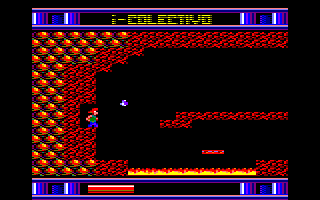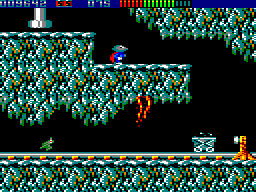
iLogicAll
(CEZ Games Studio, 2009)
A nonogram (also better known as Picross) is a puzzle where you have to fill in a grid of cells, based on a set of numbers listed beside each grid, which represent the number of filled squares in that row or column. Each grid consists of 16 rows and 16 columns, and each puzzle must be completed within a set time limit. Incorrectly marking any square as filled results in a severe time penalty, so it is advisable not to guess! There is also a password system to allow you to skip puzzles that you have already completed. The presentation is excellent and it’s a great way to exercise your brain.

Imaginario Colectivo is another new game for our machine published in 2012. The game begins with a cartoonish and colourful introduction and a mysterious tune. The game itself is an arcade adventure, so expect a lot of action. The graphics are great with detailed scenery and well designed sprites. The animation is really good and smooth, while the soundtrack is atmospheric and pleasant. There are some sound effects as well. The gameplay is fast-paced with many traps and enemies to avoid, while you need to collect objects. The in-game screens further assist the atmosphere of this great game. The scenery changes as you progress and the difficulty level is reasonable. Overall, a great game to play that will give you a lot of enjoyment!
![]() Watch a YouTube video of this game by:
jgonza.
Watch a YouTube video of this game by:
jgonza.

Imagination
(Firebird, 1987)
You’ve come home from the second-hand computer store with a floppy disc, but its label is so worn that you can’t read it. Inserting it into your computer and running it, a menu appears. When you select any of the games, you find yourself inside the game itself – wow! This is a GAC text adventure in which you must collect objects from the four games and use them in other games. Of course, this is all in your imagination, and pinching your arm while you’re in a game will take you back to your computer again. It’s not the most taxing of adventures, but it’s good fun, and quite strange as well.

Impact
(Audiogenic Software, 1988)
Hey, it’s another Breakout-style game! So what makes this one better than the others? There are 100 levels, and the game also comes with its own screen designer allowing you to design ten of your own. You also get a password every ten levels so that you don’t have to play the earlier ones. The way you collect bonuses is different, though – there are nine power-ups available, and to obtain them, you have to collect the right number of staples. It’s one of the better games of this ilk – its main advantage being that you can actually complete the first few levels!

Imperial Mahjong
(Cargosoft, 2016)
Mahjong solitaire is a tile-matching game that uses the traditional set of 144 Chinese mahjong tiles. The tiles are laid out randomly, and you can only match tiles that are ‘free’ (meaning that they are not surrounded by tiles to their left and right, and there are no tiles on top of them). What sets this game apart is the use of a unique graphical mode that the programmer has called EGX (Extended GraphX), which allows sixteen colours to be used in the CPC’s medium-resolution Mode 1. The result is simply astonishing! There are also six tunes to choose from, which use sampled drum effects. Mahjong solitaire may look daunting if you’ve never played it before, but you’ll soon understand the rules – and with a seemingly infinite variety of tile layouts, and the most beautiful graphics you’ll ever see in a CPC game, you’ll want to play it again and again.
![]() Watch a YouTube video of this game by:
Édouard Bergé.
Watch a YouTube video of this game by:
Édouard Bergé.

Impossaball
(Hewson, 1987)
Now here’s a frustrating game if ever there was one. You control a bouncing ball and move left and right along a horizontally scrolling arena. Starting on the far left, you have to knock the ball against some cylinders and avoid the various hazards such as spikes, mines, and the usual monsters, and then reach the far right of the arena before your time runs out. The graphics are a bit lacking in colour and the sound effects are simple, but the game really is ‘impossaball’, as there are too many awkward gaps you have to squeeze through, and it’s so easy to touch the spikes.

Impossamole
(Gremlin Graphics, 1990)
Monty Mole has been called out of retirement by some aliens to destroy five guardians. The adventure takes Monty through the Klondike mines, the Amazon rainforest, the Orient, and Iceland, before the final encounter in Bermuda. You can choose to play any of the first four levels in any order you want. This is a good thing, because if you had to start on a particular level, you’d never get to see the other four! It’s a very difficult game, and even worse, you’ve only got one life. The graphics are very cheerful and colourful, but there’s very little sound. Thankfully, you can play enough of the game to keep coming back to it, but it’s still much too tough.
See also: Auf Wiedersehen Monty, Monty on the Run.
![]() Watch a YouTube video of this game by:
Axelino.
Watch a YouTube video of this game by:
Axelino.

Evil Professor Elvin Atombender is engaged in a deadly game of nuclear blackmail. Using his supercomputer, he will crack the secret US nuclear missile launch codes in six hours, allowing him to destroy the world. Only Agent 4125 of the IMF (Impossible Mission Force) can stop him by entering his secret underground complex and shutting it down. With his pocket computer in hand, our hero must explore the complex rooms, avoiding the guard robots whilst searching the ordinary furniture within for passwords which enable to you to disable the bots, reset the navigation lifts and others which when combined will disable Elvin’s computer. Rather ugly looking, no speech (unlike the Commodore 64 version) and extremely difficult – but a classic nonetheless.
See also: Impossible Mission II.

Warped madman Elvin Atombender is back in another attempt at nuclear Armageddon, and after Agent 4125’s previous success in spoiling the evil professor’s plans, he is again sent in to stop him. This time he has to infiltrate his secret tower complex, and once more is taking the lifts in the rooms, jumping around hostile guard robots which have evolved to kill you in more varied ways, searching the everyday objects and furniture to get codes that can help you and which will enable you to end Atombender’s nefarious scheme. Essentially more of the same, but simply better presented this time round with mild graphical improvements, but sadly still without the speech which the CPC is quite capable of.
See also: Impossible Mission.

Inca Curse
(Paxman Promotions, 1985)
An Inca temple has lain undisturbed in the South American jungle for centuries – until now, as you are going to enter and explore the temple and get out again with as much treasure as possible. This text adventure is the second in a series of eight that were originally released for the ZX81 and ZX Spectrum, so don’t expect it to be very sophisticated. The presentation is very basic indeed; the text is displayed entirely in capital letters with numerous spelling mistakes, and the use of black text on a cyan background hurts the eyes after a while. That said, it’s actually not that bad to play. The temple is large and there are eight treasures to collect, some of which are more valuable than others, but you can only carry a maximum of six objects at a time, so there is an incentive to play the game again and again to try to obtain as high a score as possible.
See also: Planet of Death.
